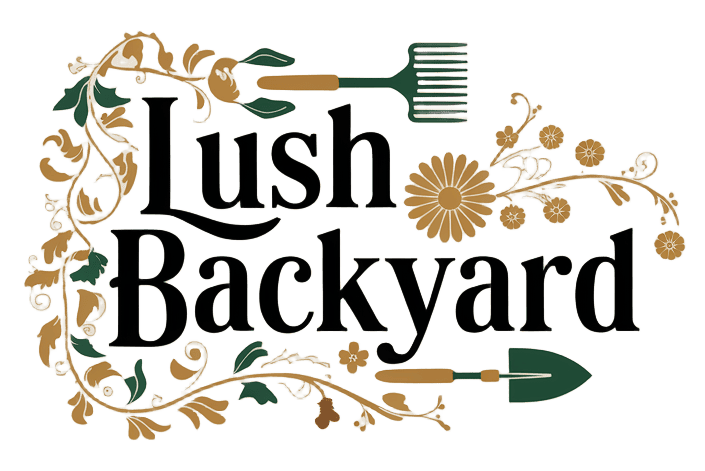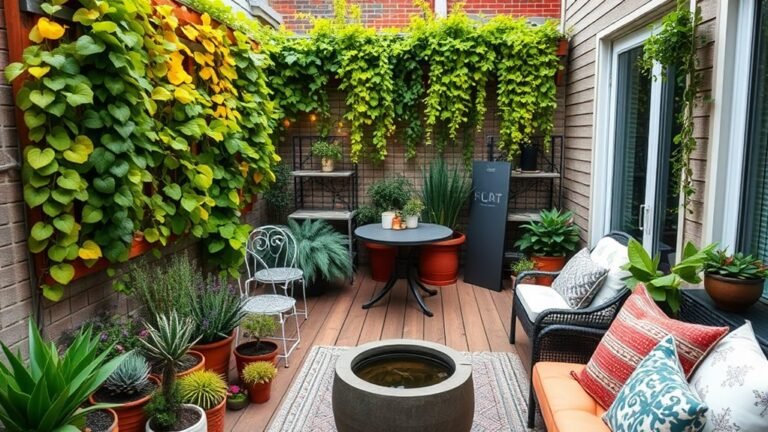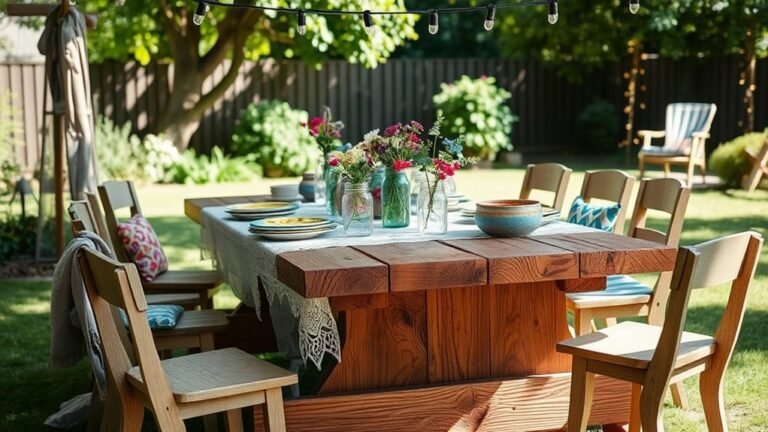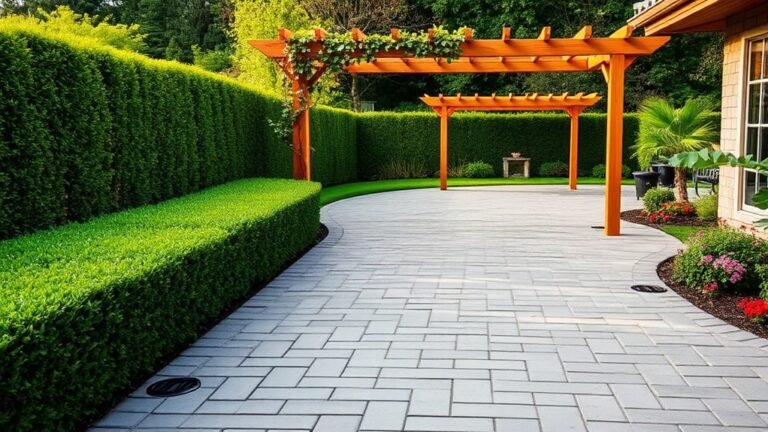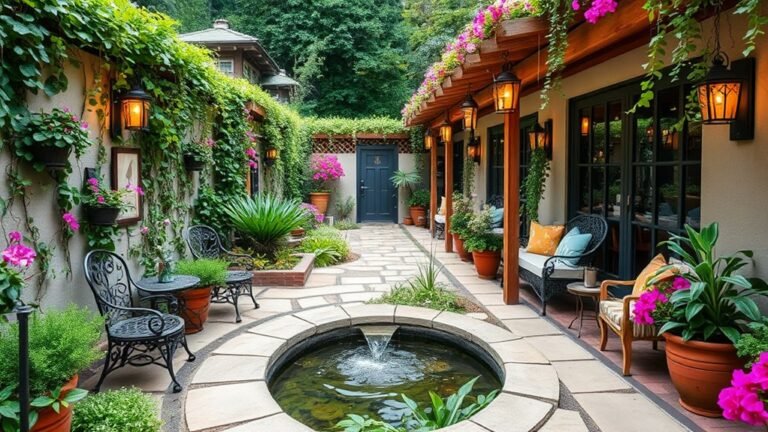14 Backyard Drainage Ditch Ideas to Fix Water Issues
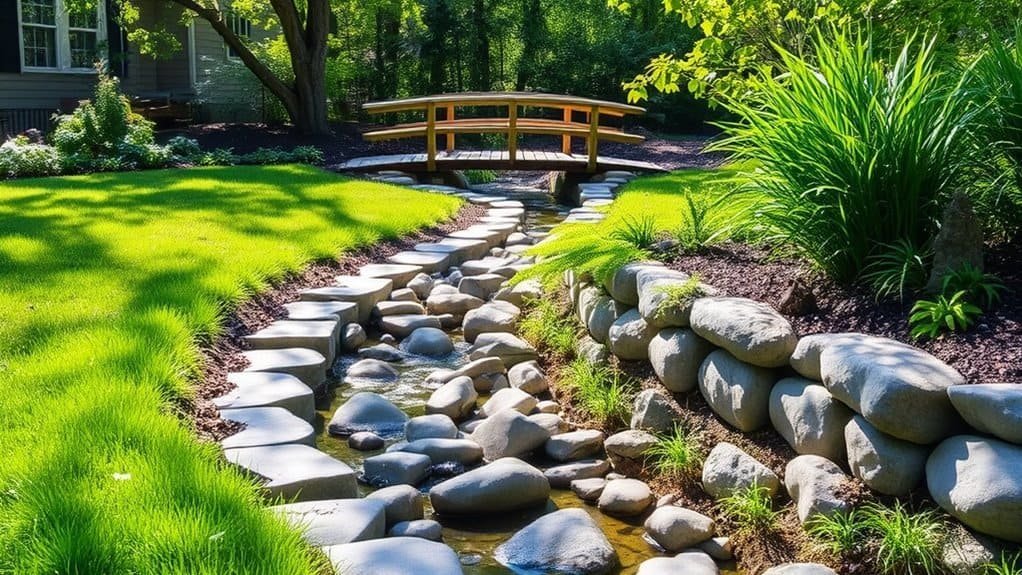
Is your backyard turning into a pond after heavy rain? Take action with 14 innovative drainage ditch ideas to transform your space from waterlogged to manageable.
From functional solutions like French drains to attractive rain gardens, each option provides a unique way to address your drainage issues. Discover which method suits your needs best.
French Drains
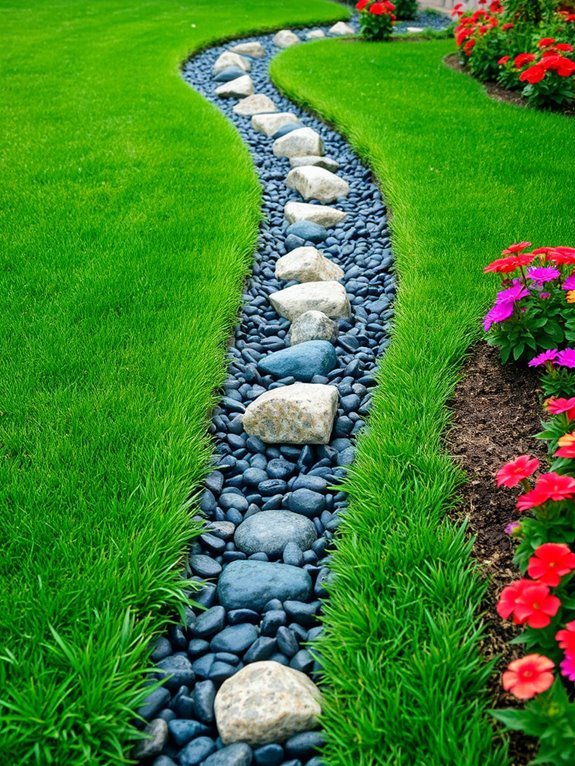
For managing excess water in your backyard, French drains are an effective solution. Picture this: a rainy day turns your yard into a mini lake—definitely not ideal! That's when a French drain comes to the rescue!
This system directs water away from problem areas, preventing flooding and soggy patches. You'll need to dig a trench, fill it with gravel, and install a perforated pipe at the bottom to collect excess water and channel it away from your garden and patio.
Installing a French drain is practical and a rewarding DIY project. With some tools and a bit of effort, you can enhance your yard.
Once it's set up, you can relax and enjoy your outdoor space without worrying about puddles. So, why not take the leap? A French drain will help you say goodbye to water issues and hello to a dry, happy backyard!
Swales
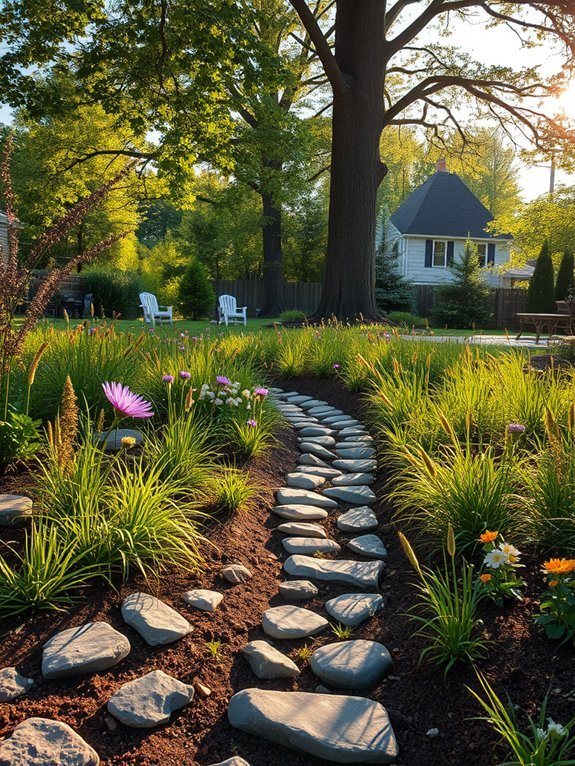
If you're seeking an effective and natural way to manage water runoff in your yard, consider installing a swale. These gently sloping channels redirect water away from your home and into areas where it can soak into the ground, while also enhancing your landscape.
To create a swale, find a spot where water pools, then dig a shallow trench that slopes downhill. Think of it as a cozy little river for your yard! Line the swale with plants and grasses that thrive in moist conditions to add color and life.
Once established, swales are low maintenance; just watch for invasive weeds, and they'll manage runoff effectively.
Dry Wells

Dry wells provide an effective solution for managing excess water in your yard, especially if flooding occurs after heavy rain. A dry well is a buried structure that collects and disperses water, preventing surface pooling.
Consider the following when thinking about dry wells:
| Aspect | Details |
|---|---|
| Purpose | Collect excess water |
| Installation | Involves digging a hole |
| Maintenance | Regularly check for blockages |
| Cost | Relatively affordable |
After installing a dry well, you'll notice your yard dries much faster after storms, while also helping the environment by allowing water to seep back into the ground. Your friends will surely envy your lush, dry lawn while theirs remains soggy. If you want to resolve pesky water issues, a dry well could be the perfect solution. Happy draining!
Rain Gardens
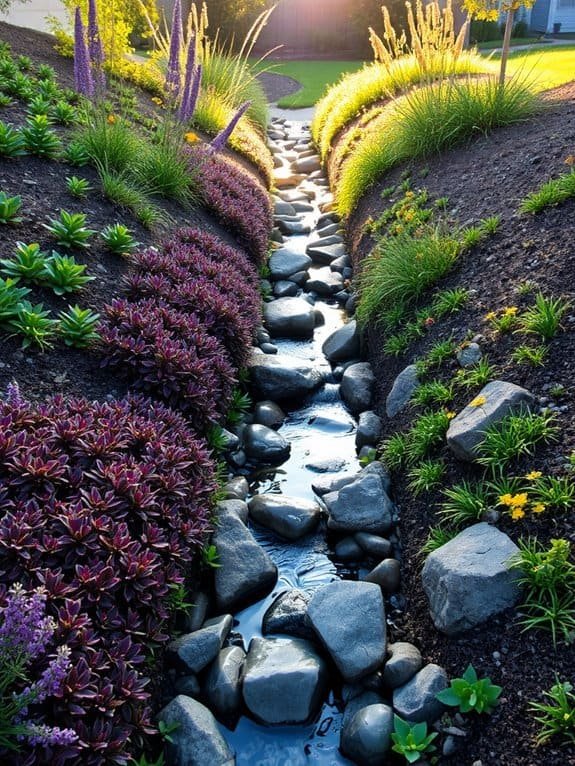
Consider creating a rain garden to manage water runoff in your yard. This eco-friendly solution addresses drainage issues while enhancing your landscape's beauty.
Picture a vibrant area filled with native plants that absorb rainwater, preventing flooding and attracting butterflies and bees.
To establish your rain garden, choose a low spot where water collects. Dig a shallow basin and use well-draining soil.
Select plants that thrive in wet conditions, like coneflowers, black-eyed Susans, and ferns, to absorb excess water and create a stunning display.
You don't need to be a gardening expert; it's about trial and error. You can also enlist friends or start a gardening club for added fun.
With some planning and effort, your rain garden will manage runoff and become a delightful oasis in your backyard.
Let's dig in and get started on this rewarding project!
Gravel Ditches
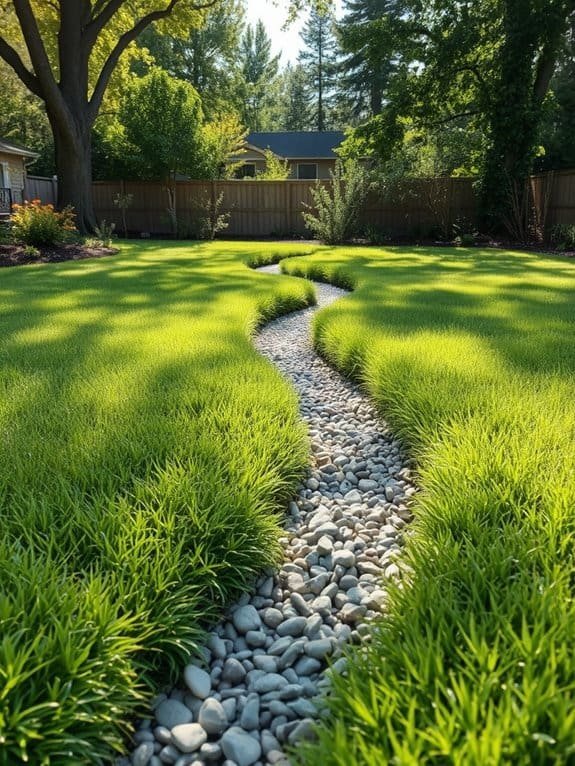
Gravel ditches provide an effective solution for backyard drainage, directing excess water away from your home and preventing flooding and erosion. They are relatively easy to install and maintain, making them a great DIY project.
To create a gravel ditch, dig a shallow trench and fill it with gravel, allowing water to flow while filtering out dirt and debris. Here's a quick comparison:
| Feature | Gravel Ditch | Benefit |
|---|---|---|
| Installation | Simple DIY | Cost-effective |
| Maintenance | Low | Less effort over time |
| Drainage Efficiency | High | Keeps yard dry |
| Aesthetic Appeal | Natural look | Blends with landscape |
Trench Drains
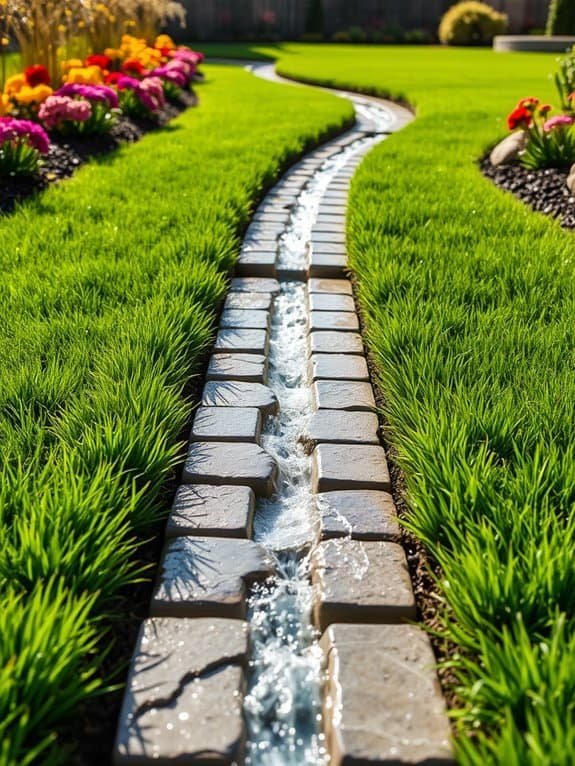
Trench drains efficiently manage water runoff in backyards, particularly in heavy rainfall areas. They consist of a sleek channel that directs water away from gardens and patios, preventing puddles that can transform your yard into a mini swimming pool.
Installing a trench drain is straightforward: dig a narrow trench, line it with gravel, and place a drain grate on top, ensuring it's sloped toward a designated drainage area, like a storm drain or dry well. This setup allows smooth water flow, keeping your yard dry and plants healthy.
Additionally, trench drains are available in various materials and designs, allowing you to enhance your outdoor space while addressing water issues.
Permeable Pavers
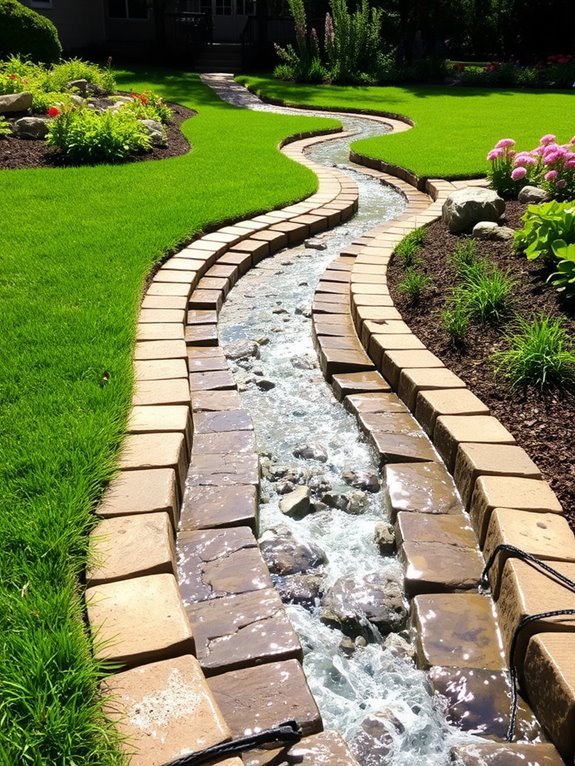
Permeable pavers effectively manage water runoff in your backyard by allowing rainwater to filter through, reducing puddles and recharging groundwater.
They can transform your driveway or patio into a stylish, eco-friendly surface that enhances drainage.
Installing permeable pavers is straightforward, with options in materials like concrete, brick, or stone, allowing you to maintain aesthetics while ensuring functionality.
Enjoy your outdoor space without the hassle of muddy messes or slippery surfaces, with designs that can complement your home.
Don't forget to maintain them!
Routine cleaning helps keep pavers looking great and functioning properly, and you might find this task surprisingly satisfying.
Catch Basins
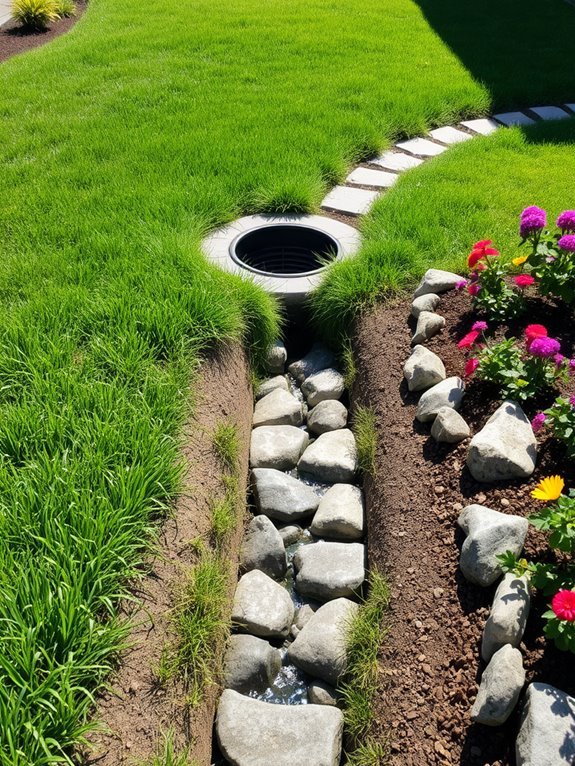
To manage excess water in your yard effectively, consider installing catch basins. These structures collect rainwater and prevent pooling, enhancing your landscape.
Here's a quick comparison of catch basins:
| Feature | Catch Basins |
|---|---|
| Water Control | Excellent |
| Maintenance | Low |
| Installation Ease | Moderate |
| Cost Efficiency | Affordable |
| Aesthetic Appeal | Versatile Design |
With a catch basin, you can eliminate waterlogged spots and muddy paths while adding a stylish element to your garden. They are both functional and an attractive landscaping feature.
Channel Drains

Channel drains are an excellent solution for directing water away from your landscaping.
These systems effectively manage excess water, keeping your yard in great shape by guiding it where you want it to go.
Here are three compelling reasons to consider installing channel drains:
- Easy Installation: You can set them up yourself with minimal guidance, saving money on professional installation.
- Versatile Design: Available in various styles and materials, you can choose a channel drain that matches your aesthetic, whether you prefer metal or natural stone.
- Effective Water Control: By directing water away from your foundation, channel drains help prevent flooding and erosion, benefiting your garden in the long run.
Retaining Walls
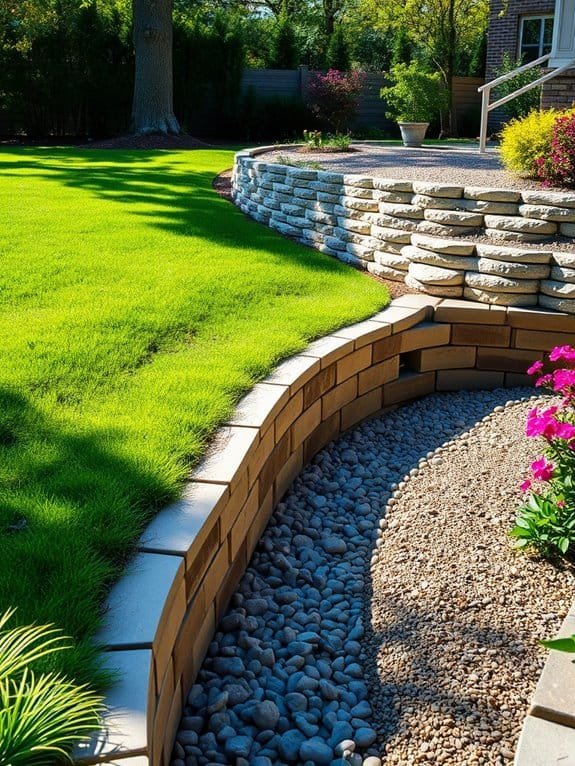
Retaining walls serve a functional role while enhancing your landscape's beauty and preventing soil erosion. They can transform a sloping backyard into a stunning tiered garden, providing structure and keeping soil in place.
Made from materials like stone, brick, or timber, they can complement your home's style.
For installation, it's manageable—you can handle smaller projects yourself or hire professionals for larger ones. Proper planning is essential, considering drainage and wall height to prevent issues.
Additionally, there's great landscaping potential! You can plant colorful flowers or robust shrubs on top or create a cozy seating area at the base, offering the ideal spot for enjoying sunny days.
Bioswales

Bioswales are effective stormwater management solutions that beautify your yard while controlling water flow, and they require minimal maintenance.
Here are three key benefits of adding bioswales to your outdoor space:
- Natural Filtration: Using plants and soil, bioswales filter pollutants from stormwater, ensuring cleaner water returns to the ground.
- Erosion Control: Their gentle slopes and vegetation prevent soil erosion, maintaining your lawn's integrity.
- Wildlife Habitat: Planting native species attracts butterflies, bees, and birds, creating a vibrant ecosystem in your yard.
Sump Pumps

If you're looking to effectively manage excess water in your yard, sump pumps can be a game changer. These devices continuously work to keep your space dry during heavy rainstorms, acting like a superhero in your basement by removing unwanted water before it causes damage.
Here's a brief overview of sump pumps to help you determine if they're right for you:
| Feature | Benefits | Considerations |
|---|---|---|
| Automatic operation | No manual monitoring needed | Requires a power source |
| Versatile use | Suitable for various settings | Installation can be complex |
| Cost-effective | Prevents costly water damage | Requires initial investment |
| Easy maintenance | Simple to clean and check | Regular checks needed |
| Portable options | Ideal for temporary use | May struggle with heavy rain |
Installing a sump pump can save you from flooding issues, and it's often a doable DIY project. Remember that pairing it with proper drainage solutions enhances effectiveness, ensuring a dry and happy yard.
Water Features
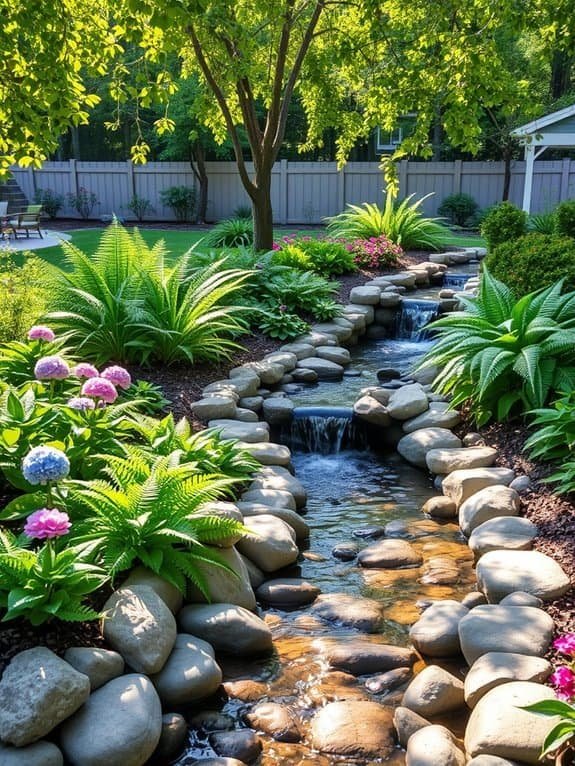
Incorporating water features into your backyard can transform it into a tranquil oasis that encourages relaxation.
Imagine lounging by a bubbling fountain, allowing the soothing sound of water to alleviate your worries. Additionally, water features can assist with drainage issues, making them a practical choice!
Here are three engaging ways to add water to your yard:
- Pond: A small pond serves as a stunning focal point, especially with fish or water plants for a mini-ecosystem. Just remember to keep the water clean!
- Waterfall: A waterfall flowing over rocks into a pond adds dynamic beauty and creates a calming ambiance, transporting you to a mini-vacation at home.
- Birdbath: For smaller spaces, a birdbath attracts birds, invigorating your yard. Plus, watching birds splash around is always enjoyable!
Landscape Grading
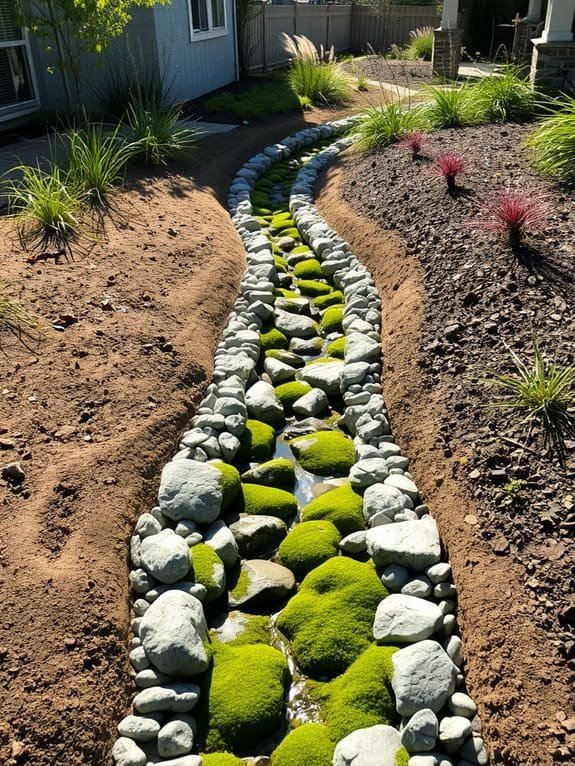
Proper landscape grading is crucial for directing water away from your home and preventing drainage problems. It involves creating a gentle slope to guide rainwater effectively.
Consider these grading methods:
| Grading Method | Benefits |
|---|---|
| Contour Grading | Improves aesthetics and reduces erosion. |
| Sloping Grading | Efficiently directs water away from foundations. |
| Terracing | Creates usable space while managing runoff. |
Frequently Asked Questions
How Do I Determine the Best Drainage Solution for My Yard?
To determine the best drainage solution for your yard, start by evaluating how water flows in your space.
Grab a shovel and dig a bit! Observe where puddles form after rain.
Next, check your soil—does it drain well or hold water like a sponge?
You might consider adding a French drain or a rain garden.
Can I Install a Drainage System Myself, or Should I Hire a Professional?
You can totally install a drainage system yourself, but it might feel like trying to juggle water balloons—tricky!
If you're handy and love a good DIY challenge, go for it! Grab your tools and channel your inner plumber.
But if you're feeling like a fish out of water or the project seems overwhelming, don't hesitate to hire a pro. They'll make sure everything flows smoothly, and you can kick back and relax!
What Are the Costs Associated With Installing Backyard Drainage Solutions?
When you're thinking about installing a drainage solution, costs can vary quite a bit.
You might spend anywhere from a few hundred to several thousand dollars, depending on the size and complexity of the job.
DIY options can save you money, but don't forget about materials and tools!
Hiring a pro? Well, you might pay for their expertise, but you'll get peace of mind.
Just make sure you've got a good plan in place!
How Often Should I Maintain My Drainage System?
You should check your drainage system at least twice a year, ideally in spring and fall.
This way, you can catch any clogs or damage before they become a big headache!
You'll want to remove leaves, debris, and anything else that's decided to make a home in there.
Think of it like giving your drainage a little spa day—keeping it happy means it'll do its job and keep your yard dry and cheerful!
What Are the Signs That My Drainage System Isn't Working Properly?
Spotting signs of a struggling drainage system can be a savvy saver of stress!
If you see soggy spots, stagnant puddles, or an increase in pesky pests, it's time to take action. You might notice unpleasant odors or a lush lawn in one area that's too good to be true.
Don't ignore gurgling sounds or slow drains either; they're trying to tell you something!
Stay vigilant, and your yard will thank you later!
Conclusion
Transform your backyard from a soggy mess into a serene oasis with these 14 drainage ditch ideas. Imagine lush rain gardens soaking up water and charming swales guiding rain away like tiny streams.
Your backyard can be both functional and beautiful while keeping pesky puddles at bay. Soon, you'll be sipping lemonade on a dry patio instead of wading through a mini lake!
